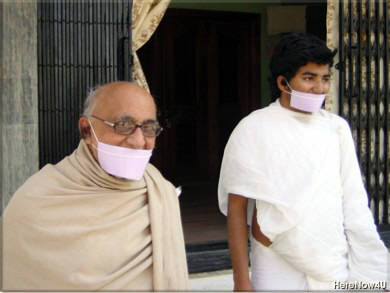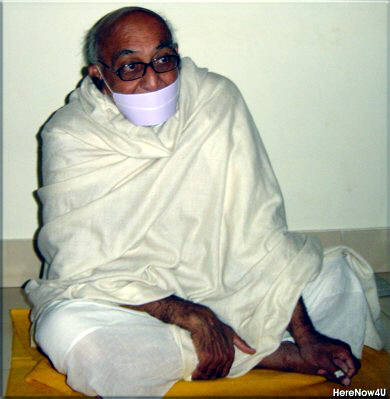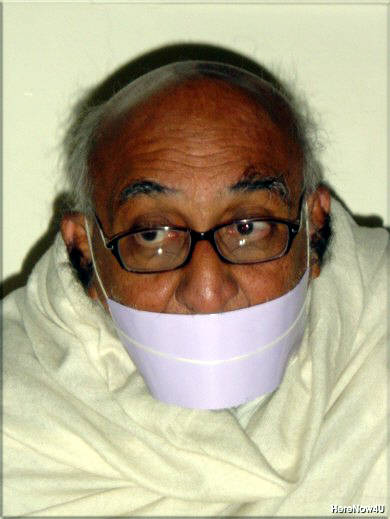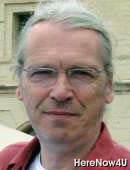
Munishree Mahendra Kumar being a highly qualified scholar of Jain philosophy, natural sciences, Meditation, and Science of Living (Jeevan Vigyan) is busy from early morning to late night. This means from 4 a.m., time of Morning Prayer, to midnight, as we were told by Kamal, a young Sadhak with whom we became acquainted in the 'Needam'.
Indefatigably editing and revising compilations, translating and authoring books, a brilliant lecturer, Munishree is also capable to express himself proficiently ready for print without manuscript.
Further he is senior disciple of H.H. Acharya Mahaprajnaji and among the Terapanth Sadhus, Sadhvis, and Samanis one of the spiritual columns as well as an archetype in generating a balanced ascetic lifestyle, filled with mental activities and spiritual realisation of the Self. His way of configuring the lifespan according to the inner and outer reality of human existence might serve as standard of orientation and inspiration for many nowadays people, if they only knew him...
Just to provide an insight into the depth of Munishree's perception, we have compiled this article from the notes taken in February 2005 during the sessions he conceded to us in spite of his busy schedule.
To add the information, how it was possible to write theses articles, we come back to Kalam. Kalam felt an urgent need from within to spend some weeks near Munishree to learn how to manage time and life without losing balance. His first lesson inspired by the presence of Munishree was how to live near a saint without occupying too much of his precious time by asking for solutions to personal problems. The result of this sensible intuition was Kamal's offer to support Munishree in his compiling work for some hours. A couple of weeks he spent some afternoon and evening hours in realisation of this honourable task.
Kamal was also the one who introduced us to Munishree with the result that Munishree gave us 30 to 45 minutes of his time in five evening sessions after the monk's Pratikraman.

Since December 2004, we were deeply involved with Anekant and had studied its principles due to the coming Einstein year 2005 and for preparation to our ‘trip to spirituality’ to JVB Ladnun where we wanted to live near the great Jain saint Acharya Mahaprajna for some weeks.
Therefore, our first question to Munishree aimed at trying to find out if any publication relating the two had come to his cognisance. He told us that until now it is not known if contemporary Jain scholars are doing any research on the connection between the teachings of Lord Mahavira and the theory of relativity.
| Addendum: Back to Berlin, we found one publication on this subject: HereNow4U - Anekanta In The Year Of Albert Einstein [02] Jainism & Relativity |
For us it was a matter of interest, because we are living in Berlin near to the place where Einstein had lived in Germany before he felt the necessity to leave the country shortly after it came under fascist government in 1933. Further, because we were on our way to the Jain Terapanth Sangh in India being headed by Acharya Mahaprajna, the author of ‘Anekant - The Third Eye’.
We asked Munishree for brief guidelines to better understand this relativity including philosophy.

1. Muni Mahendra Kumar On Anekant
The philosophy of Anekant has incorporated relativity in its very system.
Every existence has final dimensions. The nature of the world is that innate dimensions are in the living and in the unliving things. Each has it’s own set. However, my own dimensions are finite. The subjective act is to combine the dimensions with my mental combination. I can know only one dimension at a time.
At a given moment, I can say what is the dimension of length, but I have to guess what is the height, because I have only my subjective limitation of observation means.
To be sure what is the length I have to measure it.
But after that, the question is, if the height is still the same as measured before.
Things change - that’s the nature of time. Everything is moving, changing.
Observer and Observed
Jainism adds to the theory of relativity that all knowledge can only be limited. To know everything, one has to transcend time. I have the power to do so by recovering the true nature of my Self. Karma is obstructing knowledge and development of consciousness, I create by myself the covering by the actions I perform. If I know my own nature, I can do everything. The nature of the Self is to know and not to react; hatred and attachment are bound to reaction.
The Nature of Reality
I know as much as I am got to know, as far as my capacity goes. Infinite dimensions I can only know when I become free from karmic covering. The more I can remove my covering, the more I know. In life, I have to accept that I am limited to my capacities only.
Conduct
The right of living is for every being. I have no right to kill anyone and to want to live alone on the planet. Science may help us to know, but not to discriminate any human or living being.
Opposite Views
Everything is permanent and impermanent. Change and permanence belong together, i.e. look at yourself how you have been as a child, and how you are as a grown up.
Bio-Chemical Transformation
Bio-chemical transformation can be brought about through the union of science and spirituality. Science provides the information, spirituality the knowledge. Man is able to transform himself through the union of both.

The second session was filled with divers informations given by Munishree. He was answering our questions concerning present and future projects and developments.
On Electricity
Muni Mahendra Kumar was about to finish his latest book on electricity where he had proofed that electricity is not a living substance, but Pudgala. [Pudgala is a common term in Jain philosophy, Editors]
Professor Glenn Paige, Honolulu
Then he drew our attention to professor Glen B. Paige from Honolulu University. Prof. Paige has authored the book ‘Non-Killing Global Political Science’, a review of his book is available:
http://www.anis-online.de/pages/_text2/0583_essay11.htm
Prof. Paige has changed his view from justification of war in his doctoral thesis in political science to propagate non-killing political science since henceforth thirty years of his university life. He is a practitioner of Preksha Meditation and Munishree quoted him as follows, ‘I am living because I am practising Preksha Meditation.’
Ahimsa World, NGO, Bombay
In Bombay, a NGO ‘Ahimsa World’ was founded for the unity of religion and enlightened citizenship. Fifteen religious leaders are the apex body of the foundation.
Common Project Of Acharya Mahaprajna And The President Of India
Acharya Mahaprajna has agreed with the President of India, Dr. A.P.J. Abdul Kalam, to write a book together. The suggested title is ‘Beautiful Homes and Noble Nations’. The book will contain six chapters, three chapters will be written by each of them. It will deal with science, spirituality, culture, solutions for the nature, and the problems of global life.
2. Muni Mahendra Kumar On Education
Since quite long Acharyashree has the dream, that everyone’s life may be improved by education referring to both our human realities, the inward, and the outer. Education should provide the know-how for both.
In all civilisations, education is found; it is brought into being in human societies only. Why formal education is necessary?
- To perpetuate knowledge of language, i.e. reading and writing
- To provide the basics of society life

Let us have a closer look at education how it is; actually, above all, knowledge how to earn money is given. School education is for 10-12 years, then followed by university education for 5-6 years. After these 15 - 18 years one should also know how to lead a happy life, whatever life may be chosen.
Through education, the students should learn how to reach happiness in both, social and personal life. Real happiness has to come from within and does not come from outside only. All of us are happy, when the circumstances are in favour of us, but when they are not, we are losing confidence. We should learn to tolerate the external stimuli, whatever they are.
It should be the task of education to provide knowledge how to remain mentally, physically, and emotionally healthy. How to give this education? The teachings of Acharyashree are providing answers to these problems. Exercises and meditation as vital part of education offer methods for prevention of illnesses; techniques curing poor health would be more useful as well.
Further, education should help to make our peaceful nature grow to permit all members of society to live a peaceful life. I should try that other people become happy and peaceful. Education is to make a human a real human.
Another implementation for achievement is training for teachers. When teachers accept this task, they apply the right lifestyle in their own life. This way they are becoming paradigm for their students.
The 1998 Indian National Commission for Cooperation with Unesco Report ‘Learning: The Treasure Within’ (http://www.unesco.org/delors/India.htm) is on this subject. According to it, the four pillars of learning are
- Learning to know
- Learning to do
- Learning to be
- Learning to live together.
Education has to teach non-violence as an experience how to bring about the needed change towards ethical concerns and democratic values.
3. On Religion
The role of religion is to make available an education based on the principles mentioned above.
First, we have to consider how people come to follow a particular religion. Generally, people take it over from their parents, or rather from the members of their family. They are born and brought up in the context of a certain religion, and without being able to know, what are the main ideas on which their religion is based; they are quasi inheriting it.
Religion should not be inherited as it is commonly done. The ideal case for choosing a religion fitting to one’s own ideas is to get to know about all religions and then choose.
 Editor Aparigraha Jain
Editor Aparigraha Jain
 Editor Carla Geerdes
Editor Carla Geerdes